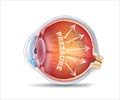A unique nanoparticle made in a laboratory at the University of Central Florida is proving promising as a drug delivery device for treating glaucoma.
Glaucoma is an eye disease that can cause blindness and affects millions of people worldwide. “The nanoparticle can safely get past the blood-brain barrier making it an effective non-toxic tool for drug delivery,” said Sudipta Seal, an engineering professor with appointments in UCF’s Advanced Materials Processing and Analysis Center and the Nanoscience Technology Center.
Seal and his colleagues from North Dakota State University note in the article that while barely 1-3 percent of existing glaucoma medicines penetrate into the eye, earlier experiments with nanoparticles have shown not only high penetration rates but also little patient discomfort. The miniscule size of the nanoparticles makes them less abrasive than some of the complex polymers now used in most eye drops.Seal and his team created a specialized cerium oxide nanoparticle and bound it with a compound that has been shown to block the activity of an enzyme (hCAII) believed to play a central role in causing glaucoma.
The disease involves abnormally high pressure of the fluid inside the eye, which, if left untreated, can result in damage to the optic nerve and vision loss. High pressure occurs, in part, because of a buildup of carbon dioxide inside the eye, and the compound blocks the enzyme that produces carbon dioxide.
Seal and a team of collaborators including Sanku Mallik, of North Dakota State University, developed the research on using nanoparticles as a delivery mechanism for the compound after supervising a student summer project at UCF. Duke University undergraduate Serge Reshetnikov spent a summer studying nanoscience on UCF’s Orlando campus as part of a Research Experience for Undergraduates (REU) project funded by the National Science Foundation. Reshetnikov started looking into the possibilities of using nanoparticles as drug delivery tools. Subsequent research with his advisors led to the specific application for glaucoma.
In their paper on the research, which was also supported by the National Science Foundation, Seal and Mallik note the results are “very promising” and that their nanoparticle configuration offers seemingly limitless possibilities as a non-toxic drug delivery tool.
Advertisement
LIN/M







